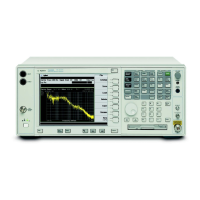Chapter 3 75
Making Measurements
Tuned RF Level Measurement
Measurement Procedure
NOTE When making Tuned RF Level measurements, optimal measurement accuracy and
speed is obtained by setting the frequency on the PSA directly using the
FREQUENCY Channel key (do not use the frequency counter).
CAUTION Press the Restart key to optimize the measuring receiver configuration if you make
any changes to the UUT or to the measuring receiver settings after you make your
first measurement.
Using a Power Meter with a N5532A/B Sensor Module (Absolute TRFL
Measurement)
Step 1. Connect, configure and verify the measurement system. See “System Hardware
Connections” on page 44 and “System Configuration” on page 47.
Step 2. Calibrate the Power Meter see “Zero and Calibrate the Power Meter” on page 53.
Step 3. Connect the sensor module to the signal source and assure proper connector care
and connector torque settings are followed. SMA/3.5 mm connectors should
receive 8 inch-pounds of torque and Type N connectors 12 in-pounds.
Step 4. On the PSA, perform the Auto Align routine by pressing
System, Alignments, Align
All Now
.
Step 5. Set the signal source amplitude and frequency. For this example use 0 dBm and 50
MHz.
Step 6. Configure the PSA settings as follows:
Table 3-2 PSA Settings
Parameter Setting
Mode Measuring Receiver
Measure Tuned RF Level
Frequency
Note: Do not use the Frequency Counter
function. You must press the Frequency
key and set the frequency manually.
Same as signal source frequency
Accuracy
(Under Meas Setup)
High
IF BW
(Under Meas Setup)
10 Hz
(default)
Range 3 Switch Delay
(Under Meas Setup, More)
Early instruments only.
ON

